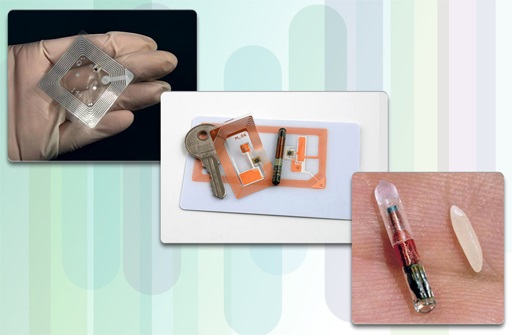2.1.6 RFID
A popular type of sensor uses radio frequency identification (RFID). RFID uses radio frequency electromagnetic fields to communicate information between small coded tags (RFID tags) and an RFID reader. Usually, RFID tags are used to identify and track what they are embedded into, such as a pet. Because the tags are small, they can be attached to virtually anything including clothing and cash. Some RFID tags carry no batteries. The energy required by the tag to transmit information is obtained from the electromagnetic signals that are sent by the RFID tag reader. The tag receives this signal and uses part of its energy to power the response.
The models shown in Figure 5 have a transmission range of a few meters, while other RFID tags are equipped with a battery and operate as a beacon that can broadcast information at all times. This type of RFID tag usually has a range of a few hundred meters. Unlike the bar code, RFID relies on radio-frequency; therefore, does not require line of sight to work.

Because of its flexibility and low power requirements, RFID tags are a great way to connect a non-computer device to an IoE solution by providing information to an RFID reader device. For example, it is now common to find car factories attaching RFID tags to the car bodies. This allows for better tracking of that car throughout the assembly line.
The first generation of RFID tags is 'write once read many'. This means that they can be programmed in the factory once, but cannot be modified out in the field. Newer RFID tags are 'write many read many', with integrated circuits that can last 40 to 50 years and be written to over 100,000 times. These tags can effectively store an entire history of the asset to which they are attached, such as the date of manufacture, location tracking history, multiple service cycle, and ownership.
